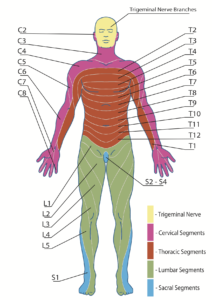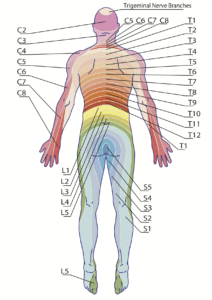This condition is an irritation or compression of one or more nerve roots in the cervical spine. Because these nerves travel to the shoulders, arms and hands, an injury in the cervical spine can cause symptoms in these areas. Cervical radiculopathy may result from a variety of problems with the bones and tissues of the cervical spinal column.
A herniated disc is known by a variety of terms, including a bulging disc, ruptured disc, torn disc or slipped disc. Discs are made up of an annulus fibrosus, which is a tough fibrous exterior layer, and the nucleus pulposis, which is a soft jelly like material.
A herniated disc occurs when the disc between a vertebrae tear and the inner gelatinous material (nucleus pulposis) leaks out (herniates).
A healthy disc has many functions. They primarily work as shock and load absorbers, protecting the bones from rubbing against each other, as well as providing flexibility to the spine.
A herniated disc can compress (put pressure) on the nerves that exit the spinal cord. This condition is sometimes known as a pinched nerve. Compression of a nerve in the cervical spine can cause pain, tingling, numbness or weakness in the shoulders, arms or hands.
They can also press on the spinal cord causing more serious issues.
CAUSES
A herniated cervical disc may be caused by a variety of reasons. Age is often a factor, with the disc wearing out due to the normal aging process. Poor posture and poor ergonomics when lifting can cause the disc to herniate. Sporting injuries can also lead to disc herniation
Contributing factors include obesity, lack of exercise, and smoking. Often the condition occurs in otherwise fit and healthy patients without pre existing spinal disorders.
SYMPTOMS
Symptoms are caused when the nerve or spinal cord is compressed by the herniated disc. The level of nerve root compression correlates with the symptoms.
Symptoms can range from mild to severe and are often aggravated by movement or certain positions of the neck. Often normal activities of daily living become very difficult to manage and have a negative impact on quality of life.
Common symptoms include:
- Dull or sharp pain that may radiate down the arms into the hands, or up into the head.
- Pain felt between the neck and shoulder blades
- Tingling, numbness or weakness in the shoulders, arms or hands.
- It is also possible to experience problems with gait and balance.
- Difficulty gripping objects
- Clumsiness or dropping objects
- Unsteadiness on feet, unexplained falls
DIAGNOSIS
A diagnosis of a herniated disc is made by taking a history of your symptoms and performing a physical examination. This often includes testing your muscle strength, nerve function and identifying areas of pain.
A CT or MRI scan is needed to confirm the diagnosis. X-Rays may be useful for identification of a collapsed disc space, but is not usually enough to identify the problem.
TREATMENT
Treatment comprises of conservative and surgical treatment options.
Conservative treatment options aim to reduce pain and associated symptoms. These include:
- anti-inflammatory and pain medications
- muscle relaxants
- physiotherapy
- steroid injections
- acupuncture
To increase the success of the treatment, two or more treatment modalities may be combined.
Surgery is indicated for patients with neurological dysfunction, and patients with persistent pain that does not improve with conservative treatment.
Surgical treatment options depend on the location of the herniated disc as well as individual anatomical factors.
ADR – Artificial Disc Replacement
This procedure is performed anteriorly (through the front of the neck). During this procedure, the neurosurgeon removes the degenerative or damaged disc and inserts an artificial disc to help maintain spine mobility and height. The artificial disc allows for motion between the two vertebrae to be maintained and avoids the need for a fusion. This is usually only possible in younger patients without significant degenerative changes in the spine.
Foraminotomy/ Discectomy
This procedure is performed posteriorly. A small portion of bone and soft tissue that overlies the spinal nerve is removed to allow access to the nerve root. Removing bony spurs compressing the nerve, creates room for the nerve to move freely through, and exit the foramen. At the same time it may be possible to remove a herniated disc to further decompress the nerve root.
ACDF- Anterior Cervical Discectomy and Fusion
This procedure is performed anteriorly (through the front of the neck). Anterior cervical discectomy is a common surgical procedure for the management of cervical disc herniation. Anterior cervical discectomy and fusion (ACDF) is a type of minimally invasive surgical procedure performed through the front of the neck to remove a herniated disc.The disc is removed and replaced with a cage, which is made of a very strong material (PEEK polymer). This cage has a cavity within it, which is packed with a bone substitute. This allows the bone above and below to grow through the cage, fusing the vertebrae together.



